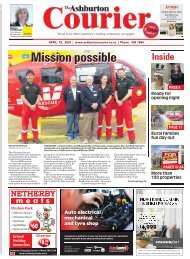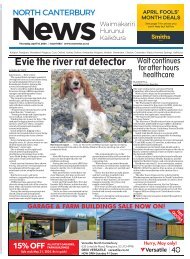Selwyn Times: April 15, 2020
You also want an ePaper? Increase the reach of your titles
YUMPU automatically turns print PDFs into web optimized ePapers that Google loves.
6 Wednesday <strong>April</strong> <strong>15</strong> <strong>2020</strong><br />
Latest Canterbury news at starnews.co.nz<br />
SELWYN TIMES<br />
News<br />
CONVENIENT: The Doyleston Creamery was one of the first to be built in Ellesmere. It was considered to be a smaller operation but its central location proved<br />
successful.<br />
Thriving dairy industry had humble start<br />
INTENSIVE dairy farming<br />
is now an important part our<br />
the district’s economy and<br />
this is evident with the recent<br />
establishment of two large<br />
local milk processing factories<br />
- Synlait’s near Dunsandel and<br />
Fonterra’s at Darfield. However,<br />
dairying has been a feature of<br />
the district since the pioneering<br />
days of the 1860s when marginal<br />
land was broken in by the early<br />
settlers.<br />
The scale of dairy farming was<br />
much different then. Most farms<br />
had at least one ‘house’ cow to<br />
provide milk for the family. Cow<br />
herds were much smaller then<br />
as milking was done by hand<br />
and very labour intensive. Other<br />
problems farmers faced was how<br />
to preserve the milk in a time<br />
when refrigeration was in its<br />
infancy and expensive, and how<br />
to get their produce to markets<br />
when the main mode of transport<br />
was a horse and cart.<br />
It is hard for us to believe now,<br />
but during the colonial era in<br />
New Zealand it was only the<br />
cream of the milk that had any<br />
financial value for farmers. This<br />
was mainly used to produce butter<br />
and cheese which were staple<br />
foods in New Zealand society<br />
at the time that could easily be<br />
made by housewives as part of<br />
their daily chores.<br />
By the late 19th-century butter<br />
and cheese was being produced<br />
on an industrial scale for both<br />
domestic and foreign markets,<br />
with much of this being exported<br />
to Britain.<br />
This led to the establishment of<br />
local creameries throughout the<br />
<strong>Selwyn</strong> district where farmers<br />
could easily deliver their milk<br />
for the separation process to sites<br />
which were only a short distance<br />
from their farms.<br />
The first commercial dairy<br />
factory built in the district was<br />
at Tai Tapu. Described as ‘the<br />
pioneer of dairy factories in Canterbury,’<br />
the substantial building<br />
of red brick and iron was opened<br />
on July 19, 1888, and funded by a<br />
local co-op initially consisting of<br />
eight shareholders. The business<br />
proved so successful that by 1903<br />
the number of shareholders had<br />
Historian and district council staff member Wayne<br />
Stack continues his monthly look at <strong>Selwyn</strong>’s past.<br />
Anyone with suggestions for future features can<br />
phone Wayne on 021 119 9107. This month’s article<br />
is about early dairying in the district.<br />
risen to 205.<br />
At the height of production,<br />
the four Burnstey and Wyner<br />
separators put 4500 gallons on<br />
milk through daily, with farms<br />
within a radius of four miles<br />
supplying the milk. In 1900<br />
the factory received 8.4 million<br />
pounds of milk which produced<br />
351,200lbs of butter.<br />
One of the first smaller<br />
creameries to be established<br />
in the Ellesmere area was that<br />
built by the Canterbury Central<br />
Co-operative Dairy Company<br />
on Drain Rd, Doyleston. Details<br />
of the exact date this facility<br />
was opened are sketchy but it is<br />
believed to be sometime in 1892<br />
when the company was first<br />
established.<br />
According to an article in the<br />
Ellesmere Guardian in October<br />
1893 initially there had been<br />
adverse criticism from a number<br />
of shareholders regarding the<br />
chosen location of the creamery,<br />
being two miles from the<br />
Doyleston railway station.<br />
However, it appeared that the<br />
initial doubts of the practical<br />
success of the creamery were<br />
dispelled as it proved to be a<br />
central and convenient location:<br />
‘With only a few exceptions the<br />
principal and good butter and<br />
cheese makers are now taking<br />
their milk to this creamery, from<br />
the Leeston, Doyleston, Killinchy<br />
and Brookside districts. Another<br />
practical fact demonstrated is<br />
that the factory system pays better<br />
than the old hand system.’<br />
The success of the creamery<br />
was evident in the number of<br />
farmers who had their milk<br />
processed there. In 1893 there<br />
were 36 local farmers supplying<br />
the facility, with an average of<br />
816 gallons of milk being processed<br />
daily by 346 cows. When<br />
separated, this produced around<br />
75 gallons of cream for which<br />
the suppliers were being paid at<br />
a rate of 1 shilling and 3 pence<br />
per pound of butter. The cream<br />
Our Great<br />
history<br />
WITH WAYNE STACK<br />
FIRST:<br />
The Tai<br />
Tapu dairy<br />
factory was<br />
described<br />
as the<br />
pioneer in<br />
Canterbury.<br />
was then transported by rail to<br />
the main Canterbury Central<br />
Co-operative Dairy Company<br />
butter factory in Addington. The<br />
company eventually built other<br />
creameries within the district at<br />
Springston, Lakeside, Irwell and<br />
Dunsandel.<br />
At this time the suppliers had<br />
stated they were very satisfied<br />
with the newly-established<br />
creamery in that, along with the<br />
reduced manual labour to the<br />
farmer’s wives and families compared<br />
to the old domestic system<br />
of making butter, the farmers<br />
were receiving an estimated 25<br />
per cent greater profit by supplying<br />
the factory.<br />
Activity at the creamery continued<br />
throughout the day. From<br />
6.30am until as late as 8.30pm<br />
farmers would continue to arrive<br />
by horse and cart to deliver metal<br />
cans full of milk and wait their<br />
turn for it to be separated and<br />
have the skim milk returned.<br />
This was then used to feed pigs,<br />
which most farmers kept for<br />
domestic meat.<br />
There was keen competition to<br />
be the first arrival at the factory<br />
in the morning, and many tales<br />
were later told of certain local<br />
farmers who gathered their cows<br />
and milked them by candle light<br />
just so they could claim to the<br />
first to deliver their milk each<br />
morning. On one occasion two<br />
suppliers arrived at the creamery<br />
at the same time and their carts<br />
became stuck trying to race<br />
through the gates in an effort to<br />
be first.<br />
Once at the creamery the<br />
farmers would drive the dray<br />
into a covered delivery loading<br />
bay in the centre of the building<br />
where the milk cans were<br />
taken and the milk placed into<br />
a separator. The cream was then<br />
stored in a vat and the leftover<br />
skim milk placed into cans and<br />
returned to the farmer before<br />
leaving. The whole process was<br />
quick and efficient, and once the<br />
benefits of supplying the creamery<br />
became well known, farmers<br />
from Irwell, Lakeside and as far<br />
as Southbridge became suppliers.<br />
The Doyleston Creamery<br />
remained in operation until the<br />
end of World War 1, after which<br />
the building was turned into a<br />
domestic dwelling sometime between<br />
1918 and 1920. In 1963 Peter<br />
and Jill Lemon purchased the<br />
property and over the years have<br />
extended and modernised the<br />
building. The only features of the<br />
original building still remaining<br />
are the concrete foundations of<br />
the separation tanks which are<br />
now part of the lounge.<br />
They have kept the history of<br />
the property alive by naming it<br />
‘The Creamery’ and it remains<br />
a permanent local reminder of<br />
the importance dairying played<br />
in the early development of the<br />
Doyleston area.


















